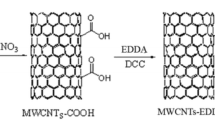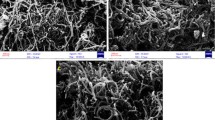Abstract
We have immobilized living and non-living Escherichia coli (E. coli) bacteria on multiwalled carbon nanotubes (MWCNT) and used such materials as a biosorbent for the separation and preconcentration of copper, cobalt, cadmium and nickel prior to their determination by flame atomic absorption spectrometry (FAAS). E. coli bacteria cells were mixed with MWCNTs in a 1:1 ratio, dried and placed at the tip of a 50-mL syringe. The ions were retained on the sorbent and then eluted by drawing and ejecting back the sample (or standard solution) and an eluent, respectively. The effects of various experimental parameters on the sorption and elution were investigated. The analytes were quantitatively retained (at pH values of 7) and eluted (with 0.5 M nitric acid) with high precision, the RSD being <5%. The performances of the new sorbents were compared using certified reference materials. The sorbent modified with living E. coli has a higher adsorption capacity and displays somewhat better recoveries compared to sorbent based on non-living E. coli. Both sorbents were successfully used for the separation and preconcentration of copper, cobalt, cadmium and nickel prior to their determination by flame atomic absorption spectrometry.

SEM photograph of (a) living E. coli immobilized on MWCNT and (b) non-living E. coli immobilized on MWCNT


Similar content being viewed by others
References
Madrid Y, Camara C (1997) Biological substrates for metal and preconcentration and speciation. Trends in Anal Chem 16:36
Mahan CA, Holcombe JA (1992) Immobilization of Algea cells on silica gel and their characterization for trace metal preconcentration. Anal Chem 64:1933
Das N (2010) Recovery of precious metals through biosorption—a review. Hydrometallurgy 103:180–189
Mack C, Wilhelmi B, Duncan JR, Burgess JE (2007) Biosorption of precious metals, review. Biotechnol Adv 25(3):264
Chojnacka K (2010) Biosorption and bioaccumulation—the prospects for practical applications, review. Environment International 36(3):299
Bag H, Lale M, Turker AR (2000) Determination of Cu, Zn, Fe, Ni and Cd by flame atomic absorption spectrometry after preconcentration by Escherichia coli immobilized on sepiolite. Talanta 51:1035
Maquieria A, Elmahadi HAM, Puchades R (1994) Use of Sacchar. Cerevisiae in flow injection atomic absorption spectrometry for trace metal preconcentration. Anal Chem 66:1462
Bag H, Turker AR, Lale M, Tunceli A (2000) Separation and speciation of Cr(III) and Cr(VI) with Saccharomyces cerevisiae immobilized on sepiolite and determination of both species in water by FAAS. Talanta 51:895
Baytak S, Turker AR (2005) The use of Agrobacterium tumefacients immobilized on Amberlite XAD-4 as a new biosorbent for the column preconcentration of iron(III), cobalt(II), manganese(II) and chromium(III). Talanta 65:938
Baytak S, Turker AR (2005) Determination of iron(III), cobalt(II) and chromium(III) in various water samples by flame atomic absorption spectrometry after preconcentration by means of saccharomyces carlsbergensis ımmobilized on amberlite XAD-4. Microchim Acta 149:109
Zhou Q, Wang W, Xiao J, Wang J, Liu G, Shi Q, Guo G (2006) Comparison of the enrichment efficiency of multiwalled carbon nanotubes, C18 silica, and activated carbon as the adsorbents for the solid phase extraction of atrazine and simazine in water samples. Microchim Acta 152:215
Karthikeyan S, Balasubramanian R, Iyer CSP (2007) Evaluation of the marine algae Ulva fasciata and Sargassum sp. for the biosorption of Cu(II) from aqueous solutions. Bioresource Technol 98:452
Tuzen M, Saygi KO, Usta C, Soylak M (2008) Pseudomonas aeruginosa immobilized multiwalled carbon nanotubes as biosorbent for heavy metal ions. Bioresource Technol 99:1563
Baytak S, Turker AR (2011) Penicillium digitatum loaded on pumice stone as a solid phase extractor for preconcentration of Co(II), Fe(III) and Ni(II). Curr Anal Chem 7(2):146
Bakircioglu Y, Bakircioglu D, Akman S (2010) Biosorption of lead by filamentous fungal biomass-loaded TiO2 nanoparticles. J Hazard Mater 178:1015
Mendil D, Tuzen M, Soylak M (2008) A biosorption system for metal ions on Penicillium italicum–loaded on Sepabeads SP 70 prior to flame atomic absorption spectrometric determinations. J Hazard Mater 152:1171
Bakircioglu Y, Bakircioglu D, Akman S (2004) Use of a packed minicolumn connected to a syringe for determination of trace elements in biological and water samples by flame atomic absorption spectrometry. Microchim Acta 148:191
Author information
Authors and Affiliations
Corresponding author
Rights and permissions
About this article
Cite this article
Aydemir, N., Tokman, N., Akarsubasi, A.T. et al. Determination of some trace elements by flame atomic absorption spectrometry after preconcentration and separation by Escherichia coli immobilized on multiwalled carbon nanotubes. Microchim Acta 175, 185–191 (2011). https://doi.org/10.1007/s00604-011-0668-2
Received:
Accepted:
Published:
Issue Date:
DOI: https://doi.org/10.1007/s00604-011-0668-2




